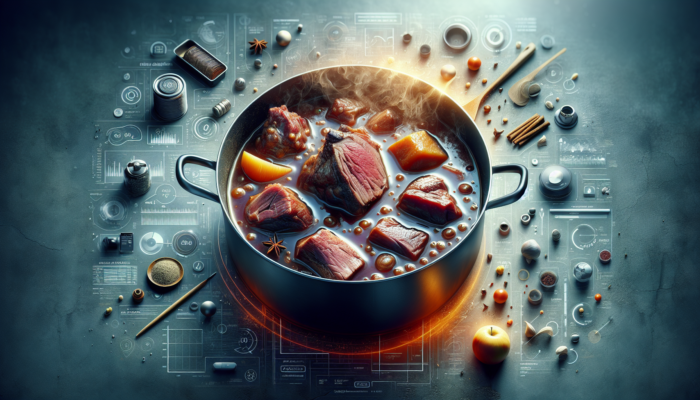Discover Essential Ingredients for Crafting Authentic Irish Stew
Choosing the Perfect Meats for Your Irish Stew Culinary Journey

Selecting the right meat is crucial when you aim to master the art of creating a delicious Irish stew. Traditionally, lamb is the star ingredient, celebrated for its rich, savory flavor that harmonizes beautifully with the other components. When choosing lamb, the best cuts to consider are the shoulder and shank, as these are ideal for slow cooking. This method transforms the meat into tender morsels over time, allowing its natural juices to mingle with the other ingredients, creating a dish that is deeply satisfying and truly warms the soul.
On the other hand, beef is also an outstanding choice for your stew, with cuts like chuck or brisket providing a robust flavor that contributes significant depth to the overall dish. When selecting beef, pay attention to the fat content; a well-marbled cut will yield a richer broth, enhancing the stew's mouthfeel. Ultimately, the choice between lamb and beef boils down to personal preference, but both options guarantee a comforting and fulfilling meal that delights both the heart and palate.
Essential Vegetables That Amplify the Flavors of Your Irish Stew
The backbone of any exceptional Irish stew is its vegetables. Carrots, potatoes, and onions are vital ingredients that contribute not only flavor but also texture. Carrots add a hint of sweetness that balances the savory notes of the meat, while potatoes provide a creamy texture as they soften and break down during cooking. These vegetables should not be considered mere fillers; they play a pivotal role in creating that authentic stew experience that warms your heart and delights your senses.
Onions are particularly important due to their aromatic properties; they create a fragrant base that enhances the entire dish. To add complexity, consider incorporating parsnips or turnips, which provide an earthy sweetness that complements the other components beautifully. Choosing seasonal vegetables can infuse your stew with fresher flavors while supporting local biodiversity, making your dish not only delicious but also environmentally friendly. Thoughtfully selecting the right mix of vegetables is essential for crafting a rich and hearty stew that truly warms the soul.
Enhance Your Stew with the Perfect Blend of Herbs and Spices
The true artistry of creating a comforting Irish stew reveals itself through your choice of herbs and spices. Classic selections such as thyme, bay leaves, and parsley significantly elevate the stew's flavor, offering a fragrant and inviting aroma. Thyme contributes an earthy undertone that beautifully complements the meat, while bay leaves add a subtle depth, enriching the overall flavor profile. These herbs are essential in crafting the rich tapestry of tastes that characterize an authentic Irish stew.
Incorporating fresh parsley just before serving not only brightens the dish visually but also infuses a fresh, grassy flavor that contrasts wonderfully with the stew's richness. For those adventurous in the kitchen, consider adding rosemary or a hint of garlic for a unique twist on this classic dish. The right combination of herbs and spices can elevate your stew, transforming it into a memorable meal that leaves a lasting impression on your guests.
Refined Techniques for Preparing Meat to Achieve Culinary Mastery

Mastering the Art of Meat Cutting for Consistent Texture and Quality
Uniformity is vital when preparing the meat for your stew. Cutting the meat into evenly sized pieces ensures that it cooks uniformly, resulting in tender bites that enhance the overall texture of the stew. Aim for chunks approximately 2 to 3 centimeters in size; this size is optimal for achieving a good browning on the outside, contributing delightful caramelization that deepens the flavor profile of your dish.
Using a sharp knife is essential for this task; it not only makes cutting easier but also ensures clean cuts that prevent the meat from tearing. As you slice, take care to remove any excess fat or sinew, as these can lead to a greasy and chewy stew. Ensuring that your meat is evenly cut and properly trimmed sets the foundation for a deliciously satisfying stew that will impress everyone gathered around the table.
The Significance of Browning Meat for Enhanced Flavor Development
Browning the meat is a crucial step in cooking a hearty Irish stew, as it develops rich flavors that infuse the broth. Begin by heating a generous amount of oil in your pot over medium-high heat. Once the oil shimmers, add the meat in batches, ensuring not to overcrowd the pot. Overcrowding can lead to steaming instead of browning, compromising the depth of flavor you aim to achieve.
Allow the meat to sear for a few minutes on each side until it develops a beautiful golden brown. This process not only enhances the flavor but also creates fond—the caramelized bits stuck to the bottom of the pot—which will significantly contribute to the stew’s rich taste. After browning all the meat, deglaze the pot with a splash of stock or wine to lift the fond, ensuring every flavor is captured in your stew. This step is vital for creating a complex and satisfying dish that showcases traditional Irish cooking at its finest.
Perfecting the Seasoning of Your Meat for Maximum Flavor Impact

Before you begin the cooking process, it’s essential to season the meat with salt and pepper to enhance its natural flavor. Generously sprinkle salt and freshly cracked black pepper over the meat, gently massaging it in to ensure even distribution. This primary seasoning step acts as the foundation for the layers of flavor that will build as the stew cooks. Never underestimate the impact of this simple yet crucial step; it is vital for developing a rich and satisfying dish.
Additionally, consider marinating the meat beforehand with spices like paprika or cumin for added complexity. This technique allows the spices to infuse into the meat, resulting in a deeper and more robust flavor profile. Remember that balancing seasoning throughout the cooking process is critical; don’t hesitate to taste and adjust as the stew simmers. Achieving the right seasoning is key to transforming a good stew into a great one, ensuring that every bite is a delightful experience.
Cooking Vegetables to Achieve Perfect Tenderness and Flavor
Efficiently Chopping Vegetables for Consistent Cooking Performance
Uniformly chopping your vegetables is a crucial aspect of cooking a hearty Irish stew. This technique ensures that all ingredients cook evenly, preventing some from becoming mushy while others remain undercooked. A good rule of thumb is to aim for similar sizes, ideally around 1 to 2 centimeters for carrots, potatoes, and onions. This uniformity not only promotes consistent cooking but also enhances the overall presentation of the dish.
Start with the onions, which typically take the longest to soften. Once diced, move on to chopping the carrots and potatoes, ensuring that you remove any eyes or blemishes for optimal texture and taste. A sharp knife is essential here; it allows for clean cuts and reduces the chances of bruising the vegetables, which can negatively affect their flavor. By taking the time to chop your vegetables thoughtfully, you're setting the stage for a delicious stew that showcases the best of fresh produce.
Sautéing Vegetables to Release Their Full Flavor Potential
Sautéing the vegetables is a vital step in the cooking process, as it releases their natural sugars and flavors. Begin by heating a splash of oil in the same pot used for browning the meat. Add the diced onions, allowing them to soften and turn translucent, which usually takes about five minutes. This stage builds a flavor base that permeates the entire stew, ensuring that every bite is utterly delicious.
Next, introduce the carrots and potatoes, stirring occasionally to prevent sticking. The goal is to achieve a slight caramelization on the edges of the vegetables, which enhances their sweetness. This technique not only adds a layer of complexity to the flavor but also allows the vegetables to maintain some of their structure, providing a delightful contrast in texture to the tender meat. A well-sautéed vegetable base is key to achieving a rich, satisfying stew that warms the heart.
Strategically Layering Vegetables for Optimal Cooking Efficiency
The order in which you layer vegetables in the pot can significantly impact the final dish. Start with the heartiest vegetables, like potatoes, at the bottom of the pot, as they require a longer cooking time. Then, add carrots and onions on top of the potatoes, allowing their flavors to meld while preserving their textures. This strategic layering promotes even cooking and prevents the ingredients from becoming overly mushy.
Consider sprinkling a pinch of salt between layers to draw out moisture and enhance the flavors. As the stew simmers, the juices from the vegetables will mingle beautifully, creating a harmonious and delicious broth that captures the essence of a traditional Irish stew. This thoughtful approach to layering not only improves the cooking process but also enhances the overall flavor and texture of the dish, resulting in a meal that is both comforting and satisfying.
Seamlessly Combining Ingredients for Stew Perfection
Selecting the Right Liquids to Enrich Your Stew
The choice of liquid is fundamental in how to cook a hearty Irish stew. Traditionally, a good-quality stock, whether beef or vegetable, forms the base of your stew. You should add just enough liquid to the pot to cover the ingredients, creating a perfect balance between the meat and vegetables. If desired, you can mix stock with water for a lighter flavor, ensuring that the stew remains rich yet not overpowering.
As the stew simmers, the liquid will reduce, concentrating flavors and creating a rich, thick broth. At this point, consider adding a splash of red wine or Guinness for a unique twist, deepening the stew’s complexity and enhancing its rich character. Adjust the liquid quantity based on the desired consistency; too much liquid can dilute flavors, while too little may result in a dry dish. Striking the right balance is key to achieving a delicious and satisfying stew that showcases the best of traditional Irish cooking.
Thoughtfully Incorporating Herbs for Maximum Flavor Impact
Integrating herbs into your stew should be done with precision to maximize flavor. Add the herbs early in the cooking process, allowing them ample time to infuse their essence into the broth. Thyme and bay leaves can be tossed into the pot simultaneously as the liquid, enabling their flavors to develop slowly as the stew simmers. This gradual infusion is crucial for achieving a well-rounded taste that enhances the dish.
However, save fresh parsley until just before serving. Its vibrant green color and fresh taste contrast beautifully with the rich, hearty stew, elevating its visual appeal. Consider tying the thyme and bay leaves in a small bundle for easy removal later. This method allows for the infusion of flavors without the worry of biting into tough leaves or stems, ensuring a smooth and enjoyable eating experience.
Regularly Adjusting Seasonings for Optimal Flavor Harmony
As the stew cooks, it’s essential to regularly taste and adjust seasonings to achieve the perfect flavor profile. Initially, focus on the foundational seasoning of salt and pepper, adding a pinch at a time and tasting after each addition. Keep in mind that the flavors will continue to develop as the stew simmers, so don’t rush this process. Taking the time to taste will ensure a harmonious balance of flavors that truly satisfies.
If the stew lacks depth, consider adding a splash of vinegar or a squeeze of lemon juice towards the end of cooking to brighten the overall taste. A dash of Worcestershire sauce can also add a savory umami note that enhances the dish. The goal is to achieve a well-rounded flavor that complements the rich ingredients without overpowering them, creating a stew that is deeply satisfying and full of flavor.
Perfectly Simmering Your Stew for Ultimate Flavor Development
Understanding Cooking Time for Optimal Tenderness
The secret to a truly comforting Irish stew lies in the simmering process. Allow your stew to simmer gently for at least two hours, or longer depending on the type of meat used. Lamb typically becomes tender faster than beef, benefiting from a longer cooking time to achieve that melt-in-your-mouth texture everyone adores. This slow cooking method melds the flavors beautifully, creating a rich and harmonious dish.
During this simmering period, the flavors meld and intensify, creating a harmonious blend of tastes that define a classic stew. Use this time to engage in other kitchen tasks or relax with a good book, knowing that the slow cooking method is working its magic. Remember to keep the heat low; a gentle simmer is what you want, as boiling can lead to tough meat and an unappealing texture. Patience is key, as the best flavors develop over time.
Stirring the Stew for Even Cooking Distribution
Occasionally stirring during the simmering process is vital to prevent food from sticking and ensure uniform cooking. As the stew bubbles away, ingredients can settle at the bottom, risking burning if left unattended. Use a wooden spoon to gently scrape the bottom of the pot, lifting any fond that may have formed. This action not only prevents the stew from sticking but also helps incorporate all the flavors, ensuring that every spoonful is a balanced mix of meat, vegetables, and broth.
If the stew thickens too much, feel free to add more liquid to maintain the desired consistency. This adaptable approach allows you to control the stew’s texture while keeping it rich and flavorful. Regularly stirring and adjusting ensures that your stew is not only delicious but also visually appealing, making it a standout dish at any meal.
Assessing Doneness in Your Stew for Perfect Texture
Determining when your Irish stew is ready involves checking both the meat and vegetables for tenderness. The meat should be fork-tender, easily shreddable with minimal resistance, while the vegetables should retain a bit of firmness, providing a satisfying bite. This contrast in texture is essential for a well-rounded stew.
To check for doneness, use a fork to test the meat’s texture. If it falls apart easily, it’s perfect. Pierce the vegetables with a knife; if it slides in effortlessly, they’re ready to be enjoyed. As you assess doneness, take a moment to taste the stew and adjust the seasonings if necessary, ensuring that each flavor is balanced before serving. This attention to detail guarantees a delectable dish that everyone will love.
Carefully Adjusting Seasonings Throughout the Cooking Process
As the stew simmers, it’s essential to remain vigilant about the seasoning. Tasting periodically allows you to gauge whether the balance of flavors is just right. If your stew tastes flat, add more salt or a hint of spice to awaken the flavors. This step is crucial in ensuring a delightful dining experience, as the right balance of seasoning can elevate the dish significantly.
Sometimes, the stew may require a touch of sweetness to counteract the savory notes. A small spoonful of sugar can be effective, particularly if the vegetables have released a lot of moisture, diluting the flavors. The objective is to achieve harmony among all components, allowing the natural essence of the ingredients to shine through. This careful attention to seasoning creates a comforting stew that is deeply satisfying and full of flavor.
Skimming the Surface for a Clear and Clean Stew
Throughout the simmering process, you may notice foam or fat rising to the surface of the stew. It’s important to skim this off to keep your stew clear and reduce greasiness. Carefully use a ladle or skimmer to remove any impurities that form on the surface. This not only improves the stew's visual appeal but also contributes to a cleaner, more refined flavor.
Regular skimming is particularly crucial if you use fattier cuts of meat, as excess fat can overpower the dish’s subtle flavors. By skimming, you’ll ensure that your hearty Irish stew remains light, enjoyable, and visually appealing. This attention to detail will impress your guests and enhance their overall dining experience.
Effective Techniques for Thickening Your Stew to Achieve Perfection
Creating a Roux for a Luxuriously Creamy Stew Consistency
If you prefer a thicker consistency for your stew, creating a roux is an excellent option. A roux is made by mixing equal parts flour and butter, which you cook together until it forms a paste. Once your stew has simmered and the flavors have developed, whisk in this mixture to help thicken the broth. This traditional method is perfect for achieving a rich and velvety consistency.
After incorporating the roux, allow the stew to simmer for an additional 20 minutes, stirring occasionally. This will help the roux fully integrate and eliminate any raw flour taste. The result is a creamy, velvety texture that elevates the overall mouthfeel and richness of the stew. A well-thickened stew not only tastes better but also looks more appealing, making it the perfect dish for serving at gatherings or family dinners.
Reducing Liquid to Achieve Natural Thickness in Your Stew
Another effective method for thickening your stew is to allow it to simmer uncovered. This process enables the liquid to reduce naturally, concentrating the flavors while thickening the broth. Keep the heat low and let it simmer for an extended period, checking occasionally to ensure it doesn’t become too thick. This technique is particularly useful for a stew made with starchier vegetables like potatoes, as they release their natural starches into the broth, contributing to a thicker consistency.
This slow reduction process enhances the stew’s depth, making each bite flavorful and satisfying. The key is to be patient and allow the flavors to develop fully while achieving the right texture. A well-reduced stew is not only delicious but also showcases the care and attention you put into preparing a traditional Irish dish.
Utilizing Potatoes as a Natural Thickening Agent in Your Stew
Potatoes are not only a key ingredient in Irish stew; they can also serve as a natural thickening agent. As the stew simmers, the potatoes break down and release their starches into the broth, creating a creamy texture. To maximize this effect, slightly mash some potatoes with a fork or potato masher before serving. This technique will thicken the stew without the need for additional ingredients, providing a simple and effective solution.
The starches from the potatoes enhance the dish’s overall flavor, creating a cohesive and hearty meal. For those seeking a gluten-free option, relying on the natural starches from potatoes or other root vegetables is a great alternative to traditional thickeners. This method simplifies the cooking process and ensures that your stew remains wholesome and satisfying.
Employing a Cornstarch Slurry for Quick and Efficient Thickening
If you’re in need of a quick solution to thicken your stew, a cornstarch slurry is an excellent choice. Mix equal parts of cornstarch with cold water until smooth, then gradually add this mixture to your simmering stew while stirring continuously. This method thickens the stew almost instantly, providing immediate results and saving you valuable time in the kitchen.
Exercise caution not to add too much cornstarch, as it can lead to an overly thick or gelatinous texture. Start with a tablespoon of cornstarch mixed with water, and add more until you achieve your desired consistency. This technique is particularly useful for individuals with dietary restrictions, offering a simple, gluten-free thickening option that maintains the integrity of your dish.
Incorporating Pureed Vegetables for Added Depth and Creaminess
Another creative approach to thickening your stew is to incorporate pureed vegetables. After your stew has simmered, remove a portion of the vegetables and broth, blending them until smooth. Then, return the pureed mixture to the pot, stirring it to thicken the consistency. This method not only enhances the richness of the stew but also adds an extra layer of flavor from the cooked vegetables.
This technique is an excellent way to obtain additional nutrients while creating a creamy texture without the need for creams or thickeners. This approach embodies the spirit of a traditional Irish stew, where simple ingredients come together to create something truly delicious. By using pureed vegetables, you ensure that your stew is hearty and nutritious, making it a wholesome option for any meal.
Creative Serving Suggestions for Your Hearty Irish Stew
Ideal Accompaniments for an Authentic Irish Dining Experience
A hearty Irish stew is best enjoyed with complementary sides that enhance its rustic charm. Crusty bread is a classic pairing, perfect for soaking up the delicious broth. Opt for freshly baked soda bread or a rustic baguette, which offers a satisfying crunch that contrasts with the stew's softness. This














